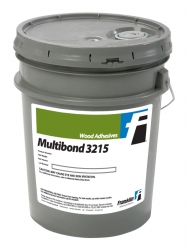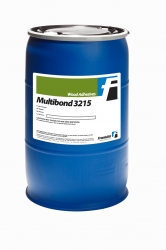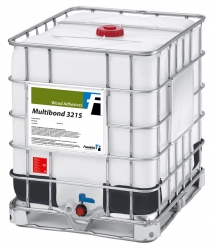Multibond 3215 Wood Glue for Laminating Applications
Multibond 3215 Wood Glue for Laminating Applications
Multibond 3215 is a one-part crosslinking polyvinyl acetate emulsion adhesive developed for a wide range of laminating as well as edge and face gluing operations. It is specially formulated with an additive that allows for easier clean-up on clamping and pressing equipment than traditional PVAs. It is highly water-resistant and offers additional protection from bleed-through on veneers.
KEY PRODUCT FEATURES:
- Excellent for hot press laminating;
- Performs well in edge and face, radio frequency and cold pressing applications;
- Bleed-through resistance;
- Water-resistant;
- Easy clean-up;
- No added formaldehyde;
- 175.105 FDA Compliant;
PERFORMANCE PROPERTIES:
- Meets requirements for ANSI/HPVA EF 2009
- Meets requirements for ANSI/HPVA HP-1-2004 Type 2
- Meets WDMA Type 1 and 2 water resistance
- Meets CARB requirements when tested in various wood constructions.
- European E-1 formaldehyde emission standard
- 175.105 FDA Compliant
PHYSICAL PROPERTIES |
|
|
Chemical family description: Crosslinking polyvinyl acetate emulsion adhesive  |
Suggested minimum use temperature:: +16°C Required Clamping Pressure: Clean-up: For easy removal of adhesive from equipment, clean up while it is still wet with warm water (this includes the glue roller and pans). For dried glue, steam and or hot water are the most effective. Using glue release agents on equipment will also allow for easier clean up. |
Press/ clamp time: Press times are dependent on the adhesive used, gluing stock type, moisture content of the stock and environmental conditions. Press times can range from a minimum press time of 30 minutes to greater than two hours. Shorter times are required under ideal conditions when using soft wood species at moisture content slightly less than eight to ten percent and factory temperatures of 68 degrees Fahrenheit/ 20 degrees Celsius. Longer press times will be required for higher density species, higher moisture contents and colder factory temperatures. It is recommended that optimum press times be determined in actual plant conditions recognizing that seasonal changes may lead to variable requirements.
Machining/ post process conditioning: After the minimum clamping time period, the panel will develop enough handling strength and can be removed and stacked out of the press. Twenty-four hours of cure is recommended before further machining. Three or four days may be required to eliminate sunken joints caused by residual moisture in the glue line.
Minimum use temperature: Curing temperatures should be higher than the minimum use temperature of the adhesive. This includes the temperature of the stock to be glued as well as the air and adhesive temperatures. If the temperatures are below the minimum use temperatures you will see a white, chalky appearance of the glue line. These bonds are usually weak.
RF cure time: Radio frequency cure times will vary from machine to machine. Machine manufacturers suggest that machines will cure between 75 and 100 square inches of glue line per minute per kilowatt. Glue joints should feel warm immediately after the cure cycle. Cure times should be determined through plant trials.
Hot Press time: Press time is dependent on the adhesive used, gluing stock type, moisture content of the stock and environmental conditions. This hot press schedule is provided as a recommended starting point. In plant testing is recommended especially for temperatures and substrate thicknesses beyond this chart.
IMPORTANT NOTICE TO CUSTOMER: The recommendations and data contained in this Product Data Sheet for use of this product are based on information Franklin believes to be reliable. They are offered in good faith without guarantee, as conditions and methods of use of our product by Customer are beyond Franklin’s control. Customer must determine the suitability of the product for a particular application before adopting it on a commercial scale. Discoloration and checking of wood veneer materials may occur with use of the product. These occurrences range in appearance, color and may also vary depending upon the species of wood veneer to which the product is applied. Such discoloration and checking may appear during or after the manufacturing process which utilizes the product. Environmental conditions in some manufacturing plants and end-use locations can contribute to discoloration and checking. Because such discoloration and checking are attributable to conditions beyond Franklin’s control, Franklin cannot assume any responsibility or liability for any discoloration and/or checking problems that might occur. All orders for Franklin products shall be subject to Franklin International, Inc.’s Standard Terms and Conditions of Sale which may be found at http://www.franklini.com/Terms_and_Conditions.aspx (“Standard Terms”). Different or additional terms proposed by Customer are expressly rejected and shall not become part of the agreement between Customer and Franklin International, Inc. with respect to any order. Contact Franklin International, Inc. immediately if you cannot access our Standard Terms and we will provide you a copy upon request. Any sale of products by Franklin to Customer is expressly conditional upon Customer’s consent to the Standard Terms, and Customer’s acceptance of any performance by, or receipt of products from, Franklin International, Inc. shall constitute Customer’s acceptance of the Standard Terms and Conditions of Sale. © Copyright 2015. All rights reserved. Franklin International. Revised 08/24/15.





